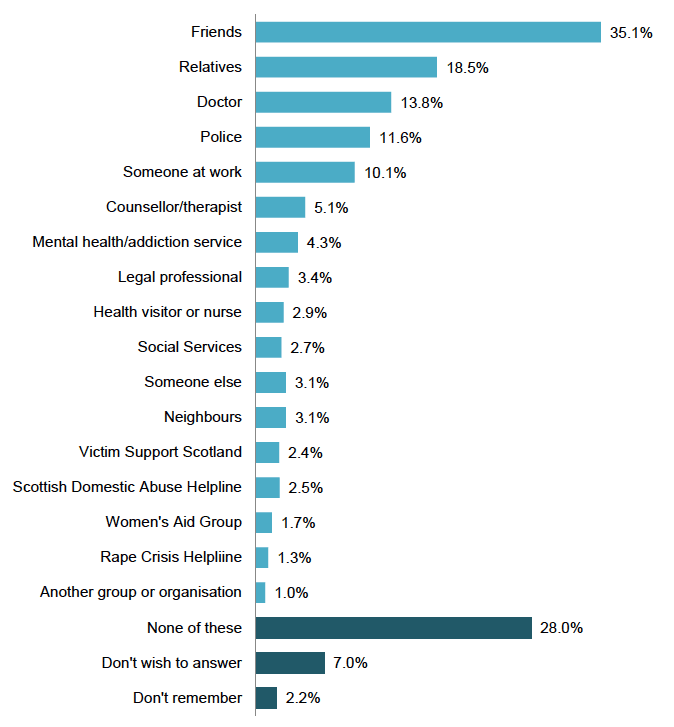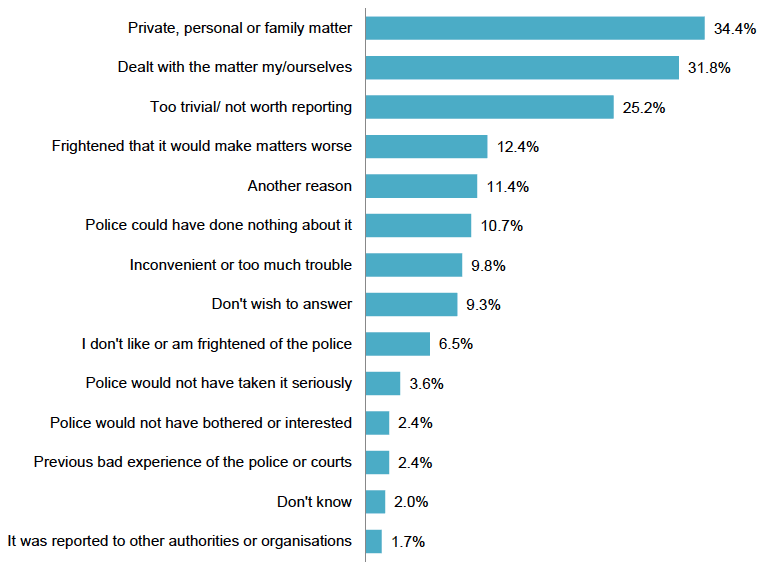Scottish Crime and Justice Survey 2014/15: Partner Abuse
Results from the Partner Abuse module of the 2014/15 Scottish Crime and Justice Survey.
4. Reporting Partner Abuse
4.1 Summary of findings
Respondents were more likely to tell people from their informal networks about their experiences of abuse, rather than professionals . Over a quarter of those who experienced partner abuse in the last twelve months appeared to tell no one about their experiences. Of those who experienced partner abuse in the last 12 months:
- Two thirds (62.8%) had told at least one person or organisation about their most recent (or only) experience of abuse.
- One third (35.1%) told friends and one fifth (18.5%) told relatives about their experiences. A further 13.8% told a doctor, and 11.6% told the police.
- One fifth (19.5%) said that the police came to know about the most recent (or only) incident of partner abuse.
- A quarter (28.0%) of those who experienced partner abuse in the last 12 months had told no one.
- Men were more likely than women to have told no one about their experiences of abuse (35.0%, compared men, compared with 23.1% respectively).
4.2 Introduction
This chapter examines reporting behaviour by victims of partner abuse. The chapter looks at the people and organizations that victims told about their experiences of abuse in the last 12 months, including the police. The chapter also examines those who told no one about their experiences, and people's reasons for not reporting partner abuse to the police. For those who did contact the police, the chapter examines satisfaction with the police response.
4.3 Who do victims tell about their abuse?
Respondents who had experienced partner abuse within the last 12 months ( n = 238) were asked who they told about the most recent (or only) incident.
Of this group, almost two-thirds (62.8%) had told at least one person or organisation about the most recent incident. A higher proportion of women than men had told at least one person or organisation about their experiences of abuse (68.1% women, compared to 55.2% men).
Respondents were most likely to have told friends (35.1%) and relatives (18.5%) about the most recent incident of abuse. In terms of contact with professionals, 13.8% told a doctor, and 11.6% reported the incident to the police. An additional 10.1% had told someone at work.
A smaller proportion of respondents reported the abuse to other professionals, such as counsellor or therapists, mental health or addiction services, social services and legal professionals. Other agencies included Women's Aid Group, Victim Support Scotland and the Scottish Domestic Abuse Helpline. A small proportion also stated that they had told 'someone else' (3.1%) or 'another group or organization' (1.0%).
Below, Figure 4.1 shows the people or organizations that respondents told about their most recent (or only) experience of partner abuse in the last 12 months.
Figure 4.1 People or organizations told about the most recent incident of partner abuse in the last 12 months

Base: All who experienced partner abuse in the last 12 months (238)
Variable name: DA_10
Results are not shown for organisations where the proportion of respondents was 1% or fewer. These were: Midwife, Housing Department, Benefit Agency, Men's advice line and Any other helpline.
4.3.1 Respondents who appeared to tell no one about their experiences
More than a quarter of those (28%) who had experienced partner abuse within the last 12 months said that they did not tell any of the organisations or individuals listed.
Given that respondents are offered a wide range of responses, including broad categories such as 'other groups or organisations' and 'someone else', it is likely that this group told no-one about their experiences. Based on this assumption, this section examines the small group that appeared to tell no one about their experiences of abuse ( n = 59). Whilst the base size is small, the results provide insights into those whose experiences of abuse otherwise remained unknown.
Men were more likely than women to have told no one about their experiences of abuse (35.0% men, compared with 23.1% women).
Looking at the age of respondents, the likelihood of telling no one was highest amongst those aged 65 or over (49.1%). There was, however, no clear-cut generational effect. Two fifths of those in their early twenties (40.9%) appeared to have told no one about their experiences of abuse in the last 12 months. Figure 4.2 shows the results.
Figure 4.2 Proportion of respondents who told no one about their experience/s of partner abuse in the last 12 months, by age group (%)

Base: All who experienced psychological abuse in last 12 months and said they had told none of the listed organisations or individuals about their experiences (59)
Variable name: DA_10_no
Whether or not a respondent told another organisation or individual about his or her experiences did not necessarily reflect the severity or frequency of abuse. For example, of those who reported two or more incidents of partner abuse in the last 12 months ( n = 70), just under a fifth (18.7%) told no one about their experiences, whilst 19.6% of those who felt that they had been a victim of domestic abuse had told no one.
4.4 Reporting to the police
Respondents who had experienced at least one incident of partner abuse in the last 12 months were asked whether the police 'came to know about' the most recent incident. This question captures whether the police came to know about the abuse, regardless of whether the victim reported the incident themselves, or if the police found out in some other way ( e.g. if someone reported on behalf of the victim).
A fifth (19.5%) [19] of those who experienced partner abuse in the last 12 months ( n = 238) stated that the police came to know about the most recent incident. This proportion is similar to the reporting rate for SCJS stalking and harassment (18.9%) and forced sexual intercourse (16.8%). It is, however, lower than the average reporting rate for all SCJS crime (38%), published in the 2014/15 Main Findings report. Within the main survey, reporting rates ranged from 28% for 'other household theft (including bicycle theft)', to 62% for housebreaking.
Of those who had experienced more than one incident of partner abuse within the last 12 months ( n = 215) 20.2% stated that the police came to know about all, or some of the other incidents (aside from the most recent incident).
Unlike the 2012/13 sweep (in which 32% women said the police came to know about the most recent incident, compared to 9% men) the 2014/15 SCJS found no statistically significant differences in reporting to the police between men and women.
4.4.1 Reporting and the criminal justice system
Of those who said that the police knew about the most recent incident of partner abuse ( n = 55), just over three quarters (77.7%) said the incident was reported as a crime. Of those cases where the most recent incident was reported as a crime ( n = 41), 35.8% said that the crime report had resulted in prosecution. The low bases mean that these figures should be treated with caution. However, the findings are consistent with academic evidence that highlights the high rate of attrition for domestic abuse offences within the criminal justice system (Hester, 2006; Barrow-Grint, 2016).
4.4.2 Reasons for not informing the police
When asked the reasons for not reporting the most recent incident of partner abuse to the police ( n = 162), the most common reasons given were that the abuse was a private, personal or family matter (34.4%), that those involved had dealt with the incident (31.8%), or that the abuse was too trivial/not worth reporting (25.2%). Around one-in-ten (9.3%) said that they did not wish to answer the question, and 11.4% stated 'another reason'.
A higher proportion of women than men said that the abuse was too trivial to report, at 32.1% and 16.6% respectively. Also, a higher proportion of women than men said that telling the police would make matters worse (17.8% women, compared to 5.6% men).
Figure 4.3 presents the range of reasons given by respondents.
Figure 4.3 Most common reasons why the most recent/only incident of partner abuse experienced in the last 12 months was not reported (%)

Base: Adults experiencing partner abuse within the last 12 months where police did not come to know about the most recent/only incident (162).
Variable name: DA_11i
4.4.3 Level of satisfaction with police
Respondents who stated that the police came to know about the most recent/only experience of partner abuse in the last 12 months ( n = 55) were asked about their satisfaction with the police response.
Of these respondents, 47.4% were very or quite satisfied with the police response, 41.3% were very or quite dissatisfied. A further 11.3% said that they were neither satisfied nor dissatisfied. Again, due to the low bases, these results should be treated with caution.
Contact
There is a problem
Thanks for your feedback